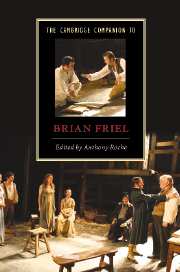Book contents
- Frontmatter
- 1 Introduction
- 2 The early plays
- 3 Surviving the 1960s: three plays by Brian Friel 1968-1971
- 4 Friel and the Northern Ireland “Troubles” play
- 5 Family affairs: Friel’s plays of the late 1970s
- 6 Five ways of looking at Faith Healer
- 7 Translations, the Field Day debate and the re-imagining of Irish identity
- 8 Dancing at Lughnasaand the unfinished revolution
- 9 The late plays
- 10 Friel’s Irish Russia
- 11 Friel and performance history
- 12 Friel’s dramaturgy: the visual dimension
- 13 Performativity, unruly bodies and gender in Brian Friel’s drama
- 14 Brian Friel as postcolonial playwright
- Bibliography
- Index
12 - Friel’s dramaturgy: the visual dimension
Published online by Cambridge University Press: 28 January 2007
- Frontmatter
- 1 Introduction
- 2 The early plays
- 3 Surviving the 1960s: three plays by Brian Friel 1968-1971
- 4 Friel and the Northern Ireland “Troubles” play
- 5 Family affairs: Friel’s plays of the late 1970s
- 6 Five ways of looking at Faith Healer
- 7 Translations, the Field Day debate and the re-imagining of Irish identity
- 8 Dancing at Lughnasaand the unfinished revolution
- 9 The late plays
- 10 Friel’s Irish Russia
- 11 Friel and performance history
- 12 Friel’s dramaturgy: the visual dimension
- 13 Performativity, unruly bodies and gender in Brian Friel’s drama
- 14 Brian Friel as postcolonial playwright
- Bibliography
- Index
Summary
The advent of electric light within theatre effected over the twentieth century a series of radical innovations in stage practice. Electricity exposed the falsities of pictorial scenery, the painted shadows, the games with perspective, showed them for what they were: illusions, tricks of the eye. The new lighting system put an end to a centuries-long tradition of scenic representation, which came patently to seem what had long been implicit within the turn-of-the-century term for stage design: decoration (deriving from the French, décor, the arranging, furnishing, color choice and tonal balance of a room, significantly an interior space, to reflect the taste, status and income of the resident). Electricity made possible a whole new approach to stage design, allowing a focus on volume and space. There were the architectural settings of Appia and Craig, constructivist settings chiefly in Russia, and Expressionist settings in Germany (often exploring power structures through the dynamic use of varying stage levels, especially in the stagings of Leopold Jessner), the presentational (as distinct from the representational), which frankly admitted its theatricality, and in time the permanent setting, where changes of location were achievable by changes to the lighting state. All to varying degrees required a major input from lighting; and electricity was discovered to be a highly flexible medium available for coloring in far subtler ways than had ever been possible with candle power or gas, and for soft, almost imperceptible gradations of intensity towards extremes of brilliance or of darkness.
- Type
- Chapter
- Information
- The Cambridge Companion to Brian Friel , pp. 129 - 141Publisher: Cambridge University PressPrint publication year: 2006



